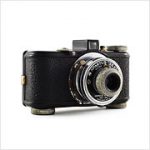Zenith Comet Specifications
| Manufacturer: | Zenith Camera Corp. |
| Origin: | USA |
| Made in: | Chicago, IL, USA |
| Introduced: | 1947 |
| Type: | Viewfinder |
| Format: | 127 Film |
| Dimensions: | 6.5 x 13.4 x 6.5 cm (closed) |
| 6.5 x 13.4 x 8 cm (open) |
Zenith Comet Overview
The Zenith Comet is a vertically-oriented viewfinder camera debuted by the Zenith Camera Corporation of Chicago in 1947. As part of the Chicago Cluster, a group of Chicago-based brands active in the 1940s including Spartus, Falcon, and Rolls which are generally believed to be multiple fronts for a single company, Zenith produced only a handful of basic models including the Comet’s close sibling: the Zenith Comet Flash. As its name might suggest, the only real difference between the Comet and the Comet Flash is the ability to use an accessory flash unit. Other than that, both models are functionally identical.
Like the Dacora Digna, M.I.O.M. Photax III, and many other cameras of its time, the Comet features a lens that must first be pulled out before it can be used. Unlike the others, however, the Comet’s lens can actually be focused by being partially extended to match distance markers engraved onto the barrel which makes it fairly unique in its class but a bit awkward to use. The camera features two aperture settings: “dull” (f/11) and “bright,” (f/16) and two shutter speeds: “instant” (approximately 1/30) and “time” (shutter stays open as long as the button is depressed). To cock the shutter between shots, a tiny knob to the right of the lens’ front element is wound.
Moving away from the lens, the knurled metal winding knob on the user’s right-hand side is used to advance the film and the latch that opens up the film door is found nearby on the bottom of the camera. In the middle of the back plate is a red window through which the user can monitor the frame number and above that is the optical viewfinder. The braided hand strap on top minimizes the chances of the Comet slipping from your grasp.
On a personal note, I wish that the Comet’s creators had put just a little bit more thought into it because the operation of this camera can be pretty clumsy. The focal distance markings are upside down which makes them annoying to use unless the lens is pointed towards the photographer and the shutter cocking mechanism is also needlessly finicky especially when you want to keep your eye on the viewfinder.
That said, the Comet’s vertical orientation, focusable lens, quirky overall design, and the fact that it was manufactured in Chicago made it a must-have for me and it took several years of waiting and watching for one of these curious little beauties before I finally found one on eBay. This example is in good condition with no cracks in the Bakelite and just a few inconsequential nicks here and there. Not bad.
Find your very own Zenith Comet on eBay.
McKeown, James M. and Joan C. McKeown’s Price Guide to Antique and Classic Cameras, 2001-2002. (Grantsburg, WI, USA: Centennial Photo Service, 2001), p 730.



















